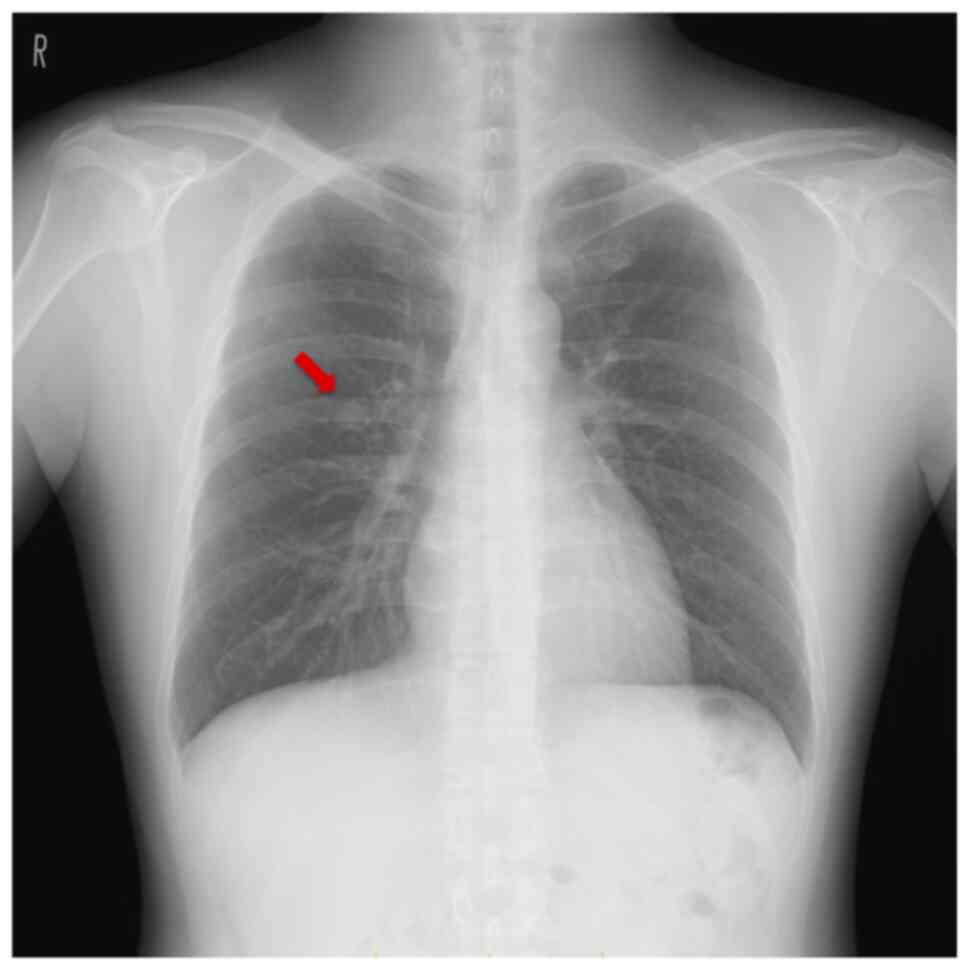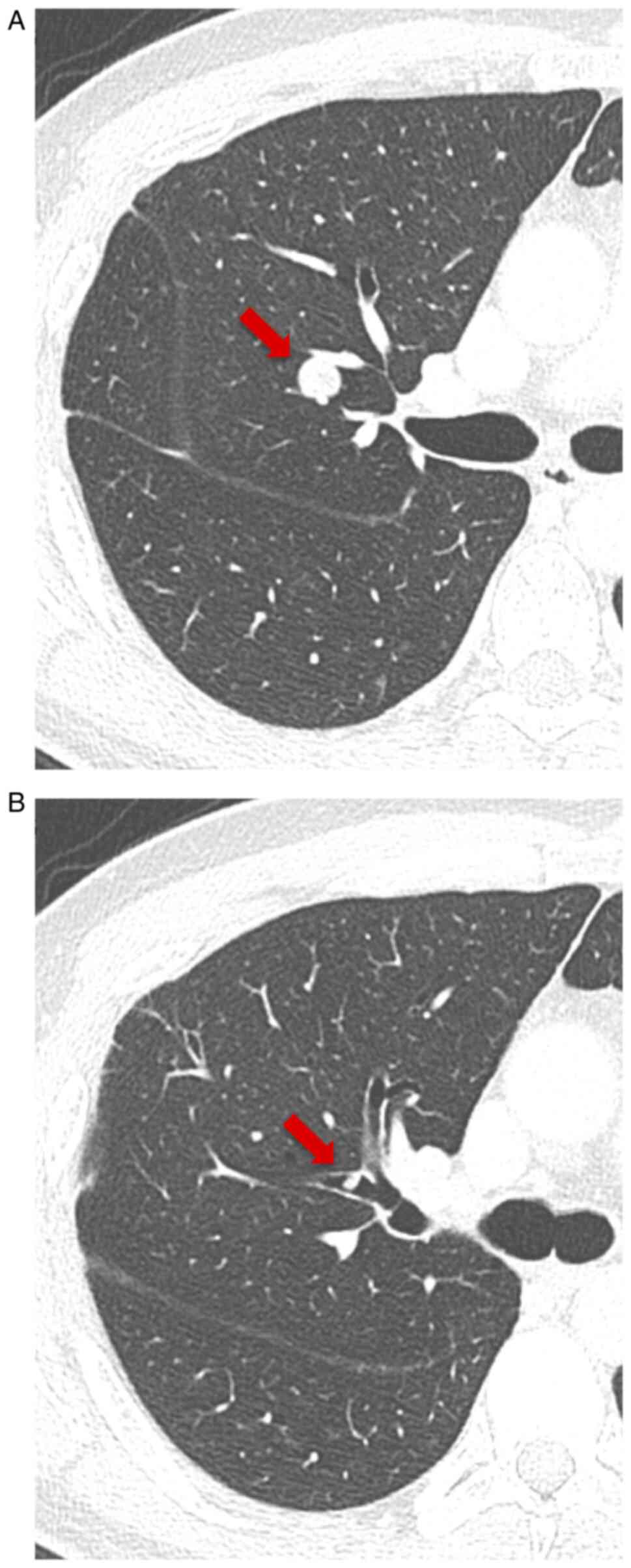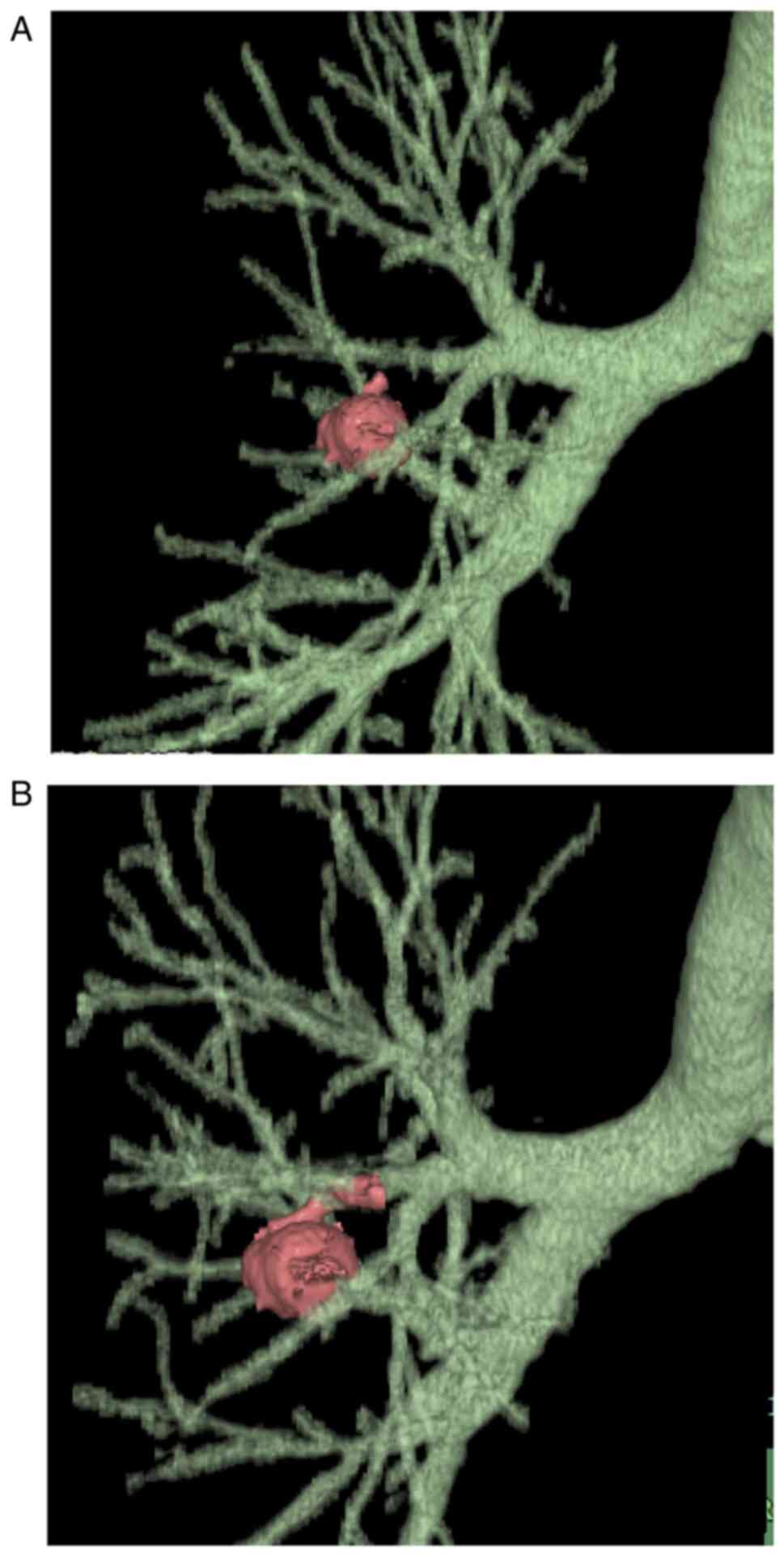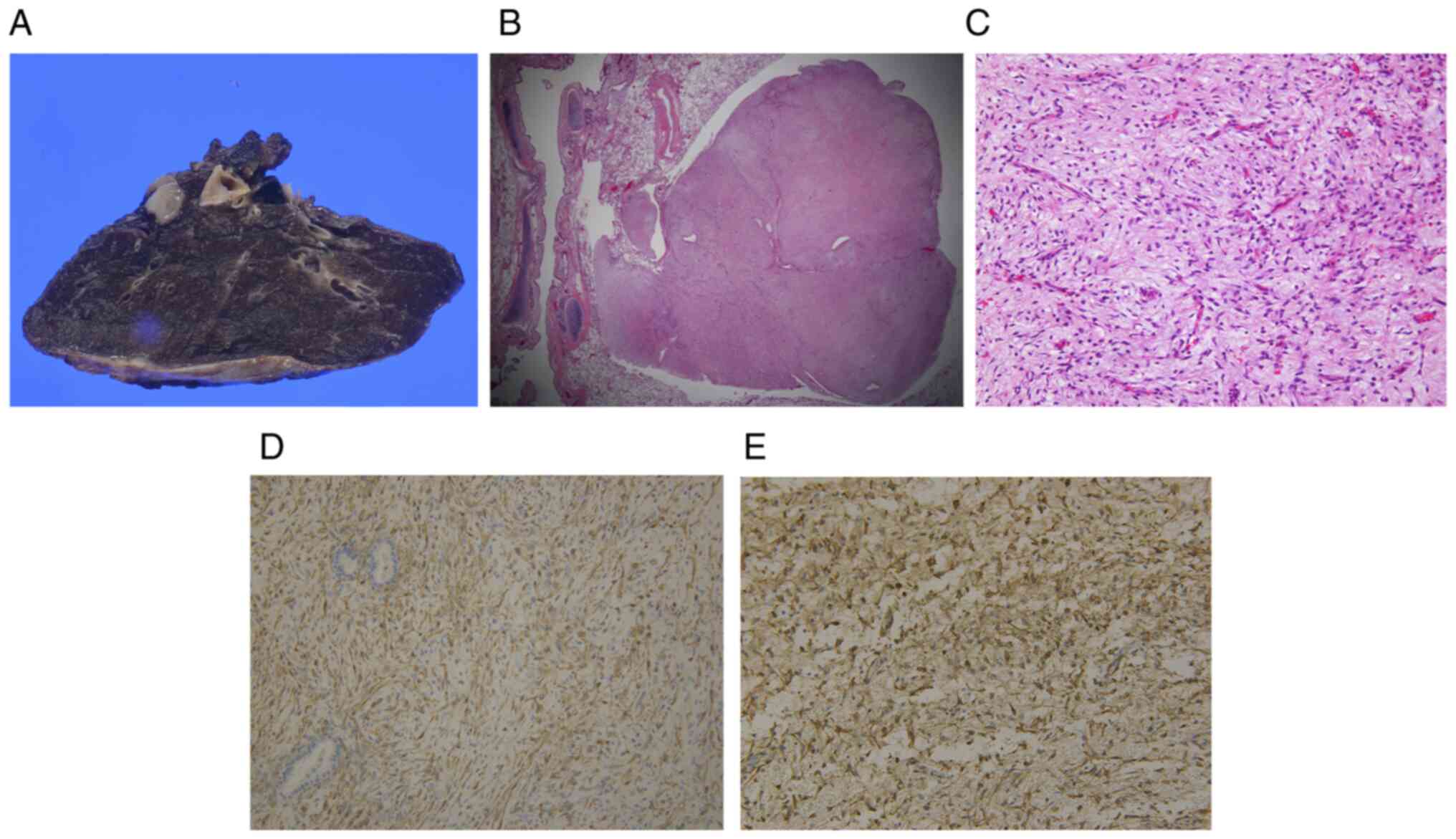Pulmonary leiomyoma with iceberg tumor growth pattern: A case report
- Authors:
- Published online on: September 5, 2022 https://doi.org/10.3892/mco.2022.2583
- Article Number: 150
-
Copyright: © Ueki et al. This is an open access article distributed under the terms of Creative Commons Attribution License.
Abstract
Introduction
Pulmonary leiomyoma is a rare benign tumor that may be classified into the tracheobronchial type which arises from the smooth muscle of the tracheobronchial wall and pulmonary parenchymal type which is considered to arise from the smooth muscle of the bronchial or small vessel wall, and the iceberg growth pattern, in which the tumor extends into both the bronchial and pulmonary cavities (1). Only four cases of iceberg growth patterns have been reported thus far and none of the cases captured the increase with time (1-3). Since most cases of tracheobronchial type is symptomatic with airway irritation, and the iceberg growth pattern tumor also extends into the bronchial cavity, resection is indicated. Furthermore, each type has many differential diagnoses such as benign disease, infections, and malignant diseases based on nonspecific radiographical findings, including CT, it is necessary to show the pathological findings for diagnosis of leiomyoma. Therefore, pulmonary leiomyoma requires endoscopic or surgical resection.
In particular, ice growth pattern tumor should resect surgically because it is located in the bronchial cavity as well as in the lung (4). We present a rare case of pulmonary leiomyoma with an iceberg tumor growth pattern expanding over time, which was resected by thoracoscopic surgery.
Case report
A 41-year-old man was referred to the National Center for Global Health and Medicine (Tokyo, Japan) in April 2020 for further examination because of an abnormal shadow on chest radiography and computed tomography (CT) images. He was a current smoker, and complained of sputum and discomfort during swallowing. His past medical history included prostatitis and hemorrhoid.
The chest radiograph revealed a smooth-surfaced nodule in the right middle lung field (Fig. 1), and CT revealed a 10-mm smooth-surfaced nodule on the right lung segment 3, which was protruding to B3b with a length of 4.6 mm. After 3 and 6 months, follow-up CTs revealed that the tumor had enlarged to 15 mm, was crawling along the intra-bronchus, and had eventually reached the bifurcation between B3a and B3b (Figs. 2A and B, and 3A and B). Neither enlarged lymph nodes nor metastases were detected on CT. Laboratory examinations revealed no renal (Cre 0.81 mg/dl) or hepatic dysfunction (AST 27 U/l, ALT 29 U/l) and tumor marker levels within the normal ranges, including the carcinoembryonic antigen (1.5 ng/ml), carbohydrate antigen 19-9 (8.0 U/ml), and squamous cell carcinoma antigen (0.8 ng/ml). Only mildly elevated levels of total cholesterol (221 mg/dl) and mild prolongation of prothrombin activation (125%) were observed. Although an intrapulmonary or bronchogenic benign tumor was suspected (e.g., pulmonary sclerosing hemangioma, hamartoma, leiomyoma, and lipoma), malignant diseases such as pulmonary carcinoid tumors could not be completely excluded because of the tumor enlargement. Therefore, we performed a robotic portal right upper lobectomy for tumor resection and diagnosis.
Intraoperatively, loose adhesions were observed throughout the entire thoracic cavity, with no disseminated disease. Adhesiotomy and right upper lobectomy was performed, and teared-polypoid lesion in the right upper bronchus was detected on bronchoscopy during the manipulation around the upper bronchus. Although en bloc resection would have been an ideal approach, the tumor was found to be fragmented and compressed in the airway during tracheal processing; hence, it was removed intraoperatively by bronchoscopy. The operative time was 5 h 7 min, and blood loss volume was 15 ml.
Pathological examination revealed that the white, smooth and lobular well-defined intrapulmonary tumor had a pedicle and was facing the bronchus (Fig. 4A-C). Both the intrapulmonary tumor and bronchial polypoid lesion had spindle-shaped stromal cell proliferation. Immunohistochemically, both showed diffuse cytoplasmic reactivity for desmin and smooth muscle actin (Fig. 4D and E), while testing negative for CD34, myogenin, and S100, indicating mesenchymal differentiation. Ki67-positive cells accounted for approximately 5% of the cells in a hot-spot. From the histopathological and immunohistochemical findings, the intrapulmonary tumor and the bronchial polypoid lesion had continuity; thus, the patient was diagnosed with pulmonary leiomyoma. He underwent pleurodesis because of prolonged air leakage, and he was discharged from the hospital on postoperative day 11. He had an uneventful course after hospital discharge without recurrence for three months.
Discussion
Pulmonary leiomyoma is a rare disease, accounts for approximately 2% of benign lung tumors (5). It can be classified by the localization of the tumor because of its different clinical features (1). The major type of leiomyoma arises from the smooth muscle of the tracheobronchial wall and is classified as the tracheobronchial type. Conversely, the pulmonary parenchymal type is considered to arise from the smooth muscle of the bronchial or small vessel wall (1). A rare population with only four reported cases, including two in the Japanese literature (Table I), have exhibited tumor extension into both bronchial and pulmonary cavities, and is called the ‘iceberg tumor growth pattern’ (1-3). Herein, we present an extremely rare case of leiomyoma with an iceberg tumor growth pattern. To the best of our knowledge, this is the first case of a leiomyoma with an iceberg growth pattern of the tumor with a process of tumor growth.
Clinically, although patients with pulmonary parenchymal leiomyomas are typically asymptomatic, patients with the tracheobronchial type may experience airway irritation symptoms such as cough, sputum, blood sputum, dyspnea, fever, chest pain, and wheezing. Moreover, tumor extension into the bronchial cavity may cause partial or complete airway obstruction, which may eventually result in bronchiectasis and recurrent lung infection (6,7). Therefore, endoscopic or surgical resection is indicated for the tracheobronchial type. Although an endoscopic resection should be attempted for pedunculated central airway lesions, an incomplete resection or tracheobronchial type lesions in the peripheral airway requires surgical resection (1-3,8). Since the iceberg growth pattern tumor extends into the bronchial cavity, resection is required. Moreover, this tumor should resect surgically because it is located in the bronchial cavity as well as in the lung (4). Past reports have described sectional resection, lobectomy, and pneumonectomy as well as bronchotomy and tracheoplasty to preserve respiratory function. In our case, the tumor showed an iceberg growth pattern in b3 and caused airway irritation symptoms, which improved soon after right middle lobectomy.
Radiologically, the leiomyoma is located intra- or extratracheally on chest radiographs. On CT, the leiomyoma presents as a smooth-surfaced solitary nodule with homogeneous or heterogeneous enhancement (9). Differential diagnoses for the tracheobronchial type are benign disease (e.g., granulomatous disease, sarcoidosis, amyloidosis, fibroepithelial polyp, and broncholith), infections (e.g., fungal, endobronchial tuberculosis, and hydatid disease), and malignant diseases such as lung cancer and bronchial carcinoid (10). Differential diagnoses of the pulmonary parenchymal type are benign tumors (e.g., hamartoma, pulmonary sclerosing hemangioma, leiomyoma, fibroid tumor, and lipoma), malignant diseases (e.g., lung cancer, metastatic lung tumor, and pulmonary carcinoid), infection (tuberculosis, non-tuberculosis mycobacterial infection, bacterial abscess, and aspergilloma), and pulmonary arteriovenous malformation (11). Because radiographical findings, including CT, are nonspecific with the tracheobronchial and pulmonary parenchymal types, pathological examination via bronchoscopy and surgical resection is necessary to diagnose pulmonary leiomyoma. Regarding the diagnosis of the iceberg growth pattern tumor, malignant diseases such as pulmonary carcinoid and mucocutaneous carcinoma should be considered (2). Our patient had a smooth-surfaced nodule in the right middle lung field on chest radiography, and CT revealed that the tumor had enlarged and crawled to the central bronchus over time. Consequently, we performed a right upper lobectomy for tumor resection and diagnosis.
Macroscopically, the tumor was white, smooth, oval, or lobular. Histologically, spindle-shaped cells were arranged in an intricate bundle-like arrangement without cytological atypia or mitosis. Sometimes, fibrous stromal proliferation or calcification was present, but no necrosis or hemorrhage was observed (12). Furthermore, we confirmed that no mitotic activity, cytological atypia, or necrosis were present.
Immunohistochemically, smooth muscle markers, such as actin and desmin, are diffusely positive in leiomyomas. Moreover, Ki-67, a marker for proliferative cells, is negative in leiomyomas (12). If nuclear palisading is detected histologically, as seen in schwannoma, immunostaining of s-100, Leu-7, actin, and desmin are valuable for the definitive diagnosis (13). In our case, the histopathological and immunohistochemical findings confirmed that the intrapulmonary tumor and bronchial polypoid lesion were the same leiomyomas, which indicated a tumor with an iceberg growth pattern.
We present a case of symptomatic iceberg growth pattern leiomyoma with a growing trend, which was removed by right upper lobectomy. After resection, the symptoms of airway irritation improved. Iceberg growth pattern leiomyoma extends into both the bronchial and pulmonary cavities; thus, surgical resection should be considered.
Acknowledgements
Not applicable.
Funding
Funding: No funding was received.
Availability of data and materials
The datasets used and/or analyzed during the current study are available from the corresponding author on reasonable request.
Authors' contributions
YU, RS, TI and SN conceived and designed the current study, acquired the data and analyzed the data. YU and RS confirm the authenticity of all the raw data. HM carried out the microscopy and contributed to the interpretation of the results. YU and RS drafted the manuscript and revised it critically. TI and SN supervised the conduct of this report. All authors read and approved the final manuscript.
Ethics approval and consent to participate
As this is a case report, approval from the institutional review board was not required.
Patient consent for publication
Written informed consent was obtained from the patient for publication of this report and any accompanying images.
Competing interests
The authors declare that they have no competing interests.
References
|
Minegishi K, Tsubochi H, Negishi H, Endo T, Otani S, Sohara Y and Endo S: A case of bronchial leiomyoma presenting with an iceberg tumor growth pattern. J Jpn Soc Respir Endoscopy. 39:308–311. 2017.(In Japanese). | |
|
Mizuno Y, Mitta S, Yamamoto H, Shirahashi K, Iwata H and Takemura H: A case of thoracoscopic right middle lobectomy for bronchial leiomyoma presenting iceberg tumor growth pattern. Jpn J Chest Surg. 28:933–936. 2014.(In Japanese). | |
|
Kim YK, Kim H, Lee KS, Han J, Yi CA, Kim J and Chung MJ: Airway leiomyoma: Imaging findings and histopathologic comparisons in 13 patients. AJR Am J Roentgenol. 189:393–399. 2007.PubMed/NCBI View Article : Google Scholar | |
|
Oka S, Yamada S, Uramoto H, Mitsuhiro M and Hanagiri T: Surgical resection of tracheal carinal leiomyoma: Report of a case. Jpn J Chest Surg. 25:392–396. 2011. | |
|
White SH, Ibrahim NB, Forrester-Wood CP and Jeyasingham K: Leiomyomas of the lower respiratory tract. Thorax. 40:306–311. 1985.PubMed/NCBI View Article : Google Scholar | |
|
Ayabe H, Tsuji H, Tagawa Y, Tomita M, Tsuda N and Chen J: Endobronchial leyomyoma: Report of a case treated by broncoplasty and a review of the literature. Surg Today. 25:1057–1060. 1995.PubMed/NCBI View Article : Google Scholar | |
|
Stevic R and Milenkovic B: Tracheobronchial tumors. J Thorac Dis. 8:3401–3413. 2016.PubMed/NCBI View Article : Google Scholar | |
|
Park JS, Lee M, Kim HK, Choi YS, Kim K, Kim J, Kim H and Shim YM: Primary leiomyoma of the trachea, bronchus, and pulmonary parenchyma-a single-institutional experience. Eur J Cardiothorac Surg. 41:41–45. 2012.PubMed/NCBI View Article : Google Scholar | |
|
Nam SW, Jeong YJ, Lee G, Lee JW, Eom JS, Lee CH and Park SM: A rare case of tracheal leiomyoma: Role of digital tomosynthesis in diagnosis and treatment. J Korean Soc Radiol. 81:225–230. 2020. | |
|
Cárdenas-García J, Lee-Chang A, Chung V, Shim C, Factor S and Tibb A: Bronchial leiomyoma, a case report and review of literature. Respir Med Case Rep. 12:59–62. 2014.PubMed/NCBI View Article : Google Scholar | |
|
Gould MK, Fletcher J, Iannettoni MD, Lynch WR, Midthun DE, Naidich DP and Ost DE: American College of Chest Physicians. Evaluation of patients with pulmonary nodules: When is it lung cancer?: ACCP evidence-based clinical practice guidelines (2nd edition). Chest. 132 (Suppl 3):108S–130S. 2007.PubMed/NCBI View Article : Google Scholar | |
|
Chiba N, Chang SS, Saito M, Ueda Y, Ishikawa S and Nakagawa T: A case of endobronchial leiomyoma suspected of being a malignant tumor. Jpn J Chest Surg. 29:141–145. 2015.(In Japanese). | |
|
Wilson RW and Kirejczyk W: Pathological and radiological correlation of endobronchial neoplasms: Part I, Benign tumors. Ann Diagn Pathol. 1:31–46. 1997.PubMed/NCBI View Article : Google Scholar |













